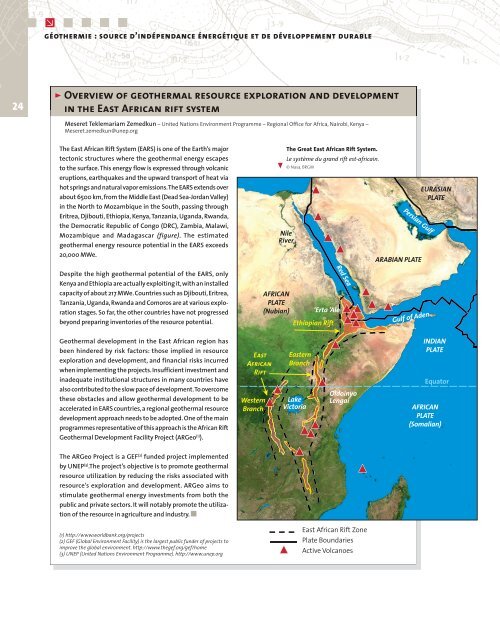revue_geosciences16
revue_geosciences16
revue_geosciences16
Create successful ePaper yourself
Turn your PDF publications into a flip-book with our unique Google optimized e-Paper software.
24<br />
géothermie : source d’indépendance énergétique et de développement durable<br />
> Overview of geothermal resource exploration and development<br />
in the East African rift system<br />
Meseret Teklemariam Zemedkun – United Nations Environment Programme – Regional Office for Africa, Nairobi, Kenya –<br />
Meseret.zemedkun@unep.org<br />
The East African Rift System (EARS) is one of the Earth’s major<br />
tectonic structures where the geothermal energy escapes<br />
to the surface. This energy flow is expressed through volcanic<br />
eruptions, earthquakes and the upward transport of heat via<br />
hot springs and natural vapor emissions. The EARS extends over<br />
about 6500 km, from the Middle East (Dead Sea-Jordan Valley)<br />
in the North to Mozambique in the South, passing through<br />
Eritrea, Djibouti, Ethiopia, Kenya, Tanzania, Uganda, Rwanda,<br />
the Democratic Republic of Congo (DRC), Zambia, Malawi,<br />
Mozambique and Madagascar (figure). The estimated<br />
geothermal energy resource potential in the EARS exceeds<br />
20,000 MWe.<br />
Despite the high geothermal potential of the EARS, only<br />
Kenya and Ethiopia are actually exploiting it, with an installed<br />
capacity of about 217 MWe. Countries such as Djibouti, Eritrea,<br />
Tanzania, Uganda, Rwanda and Comoros are at various exploration<br />
stages. So far, the other countries have not progressed<br />
beyond preparing inventories of the resource potential.<br />
Geothermal development in the East African region has<br />
been hindered by risk factors: those implied in resource<br />
exploration and development, and financial risks incurred<br />
when implementing the projects. Insufficient investment and<br />
inadequate institutional structures in many countries have<br />
also contributed to the slow pace of development. To overcome<br />
these obstacles and allow geothermal development to be<br />
accelerated in EARS countries, a regional geothermal resource<br />
development approach needs to be adopted. One of the main<br />
programmes representative of this approach is the African Rift<br />
Geothermal Development Facility Project (ARGeo (1) ).<br />
The ARGeo Project is a GEF (2) funded project implemented<br />
by UNEP (3) .The project’s objective is to promote geothermal<br />
resource utilization by reducing the risks associated with<br />
resource’s exploration and development. ARGeo aims to<br />
stimulate geothermal energy investments from both the<br />
public and private sectors. It will notably promote the utilization<br />
of the resource in agriculture and industry. ■<br />
(1) http://www.worldbank.org/projects<br />
(2) GEF (Global Environment Facility) is the largest public funder of projects to<br />
improve the global environment. http://www.thegef.org/gef/home<br />
(3) UNEP (United Nations Environment Programme). http://www.unep.org<br />
East<br />
African<br />
Rift<br />
Western<br />
Branch<br />
The Great East African Rift System.<br />
Le système du grand rift est-africain.<br />
© Nasa, BRGM<br />
Nile<br />
River<br />
AFRICAN<br />
PLATE<br />
(Nubian) ‘Erta ’Ale<br />
Ethiopian Rift<br />
Eastern<br />
Branch<br />
Lake<br />
Victoria<br />
Red Sea<br />
Oldoinyo<br />
Lengai<br />
East African Rift Zone<br />
Plate Boundaries<br />
Active Volcanoes<br />
Persian Gulf<br />
ARABIAN PLATE<br />
Gulf of Aden<br />
EURASIAN<br />
PLATE<br />
INDIAN<br />
PLATE<br />
Equator<br />
AFRICAN<br />
PLATE<br />
(Somalian)












